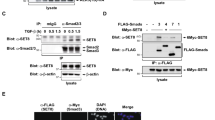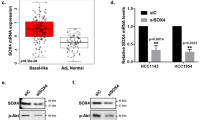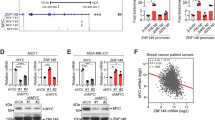Abstract
Smad proteins are central mediators in the canonical transforming growth factor-β (TGF-β) signaling pathway in mammalian cells. We report here that bromodomain-containing protein 7 (BRD7) functions as a novel transcription coactivator for Smads in TGF-β signaling. BRD7 forms a TGF-β inducible complex with Smad3/4 through its N-terminal Smad-binding domain. BRD7 simultaneously binds to acetylated histones to promote Smad-chromatin association, and associates with histone acetyltransferase p300 to enhance Smad transcriptional activity. Ectopic expression of BRD7, but not its mutants defective in Smad binding, enhances TGF-β transcriptional, tumor-suppressing and epithelial-mesenchymal transition responses. Conversely, depletion of BRD7 inhibits TGF-β responses. Thus, our study provides compelling evidence for a new function of BRD7 in fine-tuning TGF-β physiological responses.
This is a preview of subscription content, access via your institution
Access options
Subscribe to this journal
Receive 50 print issues and online access
$259.00 per year
only $5.18 per issue
Buy this article
- Purchase on Springer Link
- Instant access to full article PDF
Prices may be subject to local taxes which are calculated during checkout






Similar content being viewed by others
Abbreviations
- acH3K9:
-
acetyl histone H3 Lys9
- BMP:
-
bone morphogenetic protein
- BRD7:
-
bromodomain-containing protein 7
- EMT:
-
epithelial-mesenchymal transition
- GST:
-
glutathione S-transferase
- HAT:
-
histone acetyltransferase
- P/CAF:
-
p300/CBP-associated factor
- qRT-PCR:
-
quantitative real-time PCR
- SIP1:
-
Smad-interacting protein 1
- TGF:
-
transforming growth factor beta
- TGIF:
-
TG-interacting factor
- SMIF:
-
Smad4-interacting protein
- SXS motif:
-
Ser-X-Ser motif
- WT:
-
wild-type.
References
Wu MY, Hill CS . Tgf-beta superfamily signaling in embryonic development and homeostasis. Dev Cell 2009; 16: 329–343.
Massague J, Gomis RR . The logic of TGFbeta signaling. FEBS Lett 2006; 580: 2811–2820.
Derynck R, Miyazono K (eds). The TGF-beta Family: Cold Spring Harbor Laboratory Press: Cold Spring Harbor, New York, NY, USA, 2007.
Massague J . TGF-beta signalling in context. Nat Rev Mol Cell Biol 2012; 13: 616–630.
Shi Y, Massague J . Mechanisms of TGF-beta signaling from cell membrane to the nucleus. Cell 2003; 113: 685–700.
Miyazono K, ten Dijke P, Heldin CH . TGF-beta signaling by Smad proteins. Adv Immunol 2000; 75: 115–157.
Ross S, Hill CS . How the Smads regulate transcription. Int J Biochem Cell Biol 2008; 40: 383–408.
Feng XH, Derynck R . Specificity and versatility in tgf-beta signaling through Smads. Annu Rev Cell Dev Biol 2005; 21: 659–693.
Massague J, Seoane J, Wotton D . Smad transcription factors. Genes Dev 2005; 19: 2783–2810.
Chan HM, La Thangue NB . p300/CBP proteins: HATs for transcriptional bridges and scaffolds. J Cell Sci 2001; 114: 2363–2373.
Feng XH, Zhang Y, Wu RY, Derynck R . The tumor suppressor Smad4/DPC4 and transcriptional adaptor CBP/p300 are coactivators for smad3 in TGF-beta-induced transcriptional activation. Genes Dev 1998; 12: 2153–2163.
Bai RY, Koester C, Ouyang T, Hahn SA, Hammerschmidt M, Peschel C et al. SMIF, a Smad4-interacting protein that functions as a co-activator in TGFbeta signalling. Nat Cell Biol 2002; 4: 181–190.
Itoh S, Ericsson J, Nishikawa J, Heldin CH, ten Dijke P . The transcriptional co-activator P/CAF potentiates TGF-beta/Smad signaling. Nucleic Acids Res 2000; 28: 4291–4298.
Verschueren K, Remacle JE, Collart C, Kraft H, Baker BS, Tylzanowski P et al. SIP1, a novel zinc finger/homeodomain repressor, interacts with Smad proteins and binds to 5'-CACCT sequences in candidate target genes. J Biol Chem 1999; 274: 20489–20498.
Wotton D, Lo RS, Lee S, Massague JA . Smad transcriptional corepressor. Cell 1999; 97: 29–39.
Mantovani F, Drost J, Voorhoeve PM, Del Sal G, Agami R . Gene regulation and tumor suppression by the bromodomain-containing protein BRD7. Cell Cycle 2010; 9: 2777–2781.
Chiu YH, Lee JY, Cantley LC . BRD7, a tumor suppressor, interacts with p85alpha and regulates PI3K activity. Mol Cell 2014; 54: 193–202.
Burrows AE, Smogorzewska A, Elledge SJ . Polybromo-associated BRG1-associated factor components BRD7 and BAF180 are critical regulators of p53 required for induction of replicative senescence. Proc Natl Acad Sci USA 2010; 107: 14280–14285.
Drost J, Mantovani F, Tocco F, Elkon R, Comel A, Holstege H et al. BRD7 is a candidate tumour suppressor gene required for p53 function. Nat Cell Biol 2010; 12: 380–389.
Harte MT, O'Brien GJ, Ryan NM, Gorski JJ, Savage KI, Crawford NT et al. BRD7, a subunit of SWI/SNF complexes, binds directly to BRCA1 and regulates BRCA1-dependent transcription. Cancer Res 2010; 70: 2538–2547.
Liu H, Zhang L, Niu Z, Zhou M, Peng C, Li X et al. Promoter methylation inhibits BRD7 expression in human nasopharyngeal carcinoma cells. BMC Cancer 2008; 8: 253.
Wu WJ, Hu KS, Chen DL, Zeng ZL, Luo HY, Wang F et al. Prognostic relevance of BRD7 expression in colorectal carcinoma. Eur J Clin Invest 2013; 43: 131–140.
Park YA, Lee JW, Kim HS, Lee YY, Kim TJ, Choi CH et al. Tumor suppressive effects of bromodomain-containing protein 7 (BRD7) in epithelial ovarian carcinoma. Clin Cancer Res 2014; 20: 565–575.
Balasubramanian A, Subramaniam R, Narayanan V, Annamalai T, Ramanathan A . BRD7 promoter hypermethylation as an indicator of well differentiated oral squamous cell carcinomas. Asian Pac J Cancer Prev 2015; 16: 1615–1619.
Li CY, Suardet L, Little JB . Potential role of WAF1/Cip1/p21 as a mediator of TGF-beta cytoinhibitory effect. J Biol Chem 1995; 270: 4971–4974.
Peng C, Zhou J, Liu HY, Zhou M, Wang LL, Zhang QH et al. The transcriptional regulation role of BRD7 by binding to acetylated histone through bromodomain. J Cell Biochem 2006; 97: 882–892.
Liu F, Hata A, Baker JC, Doody J, Carcamo J, Harland RM et al. A human Mad protein acting as a BMP-regulated transcriptional activator. Nature 1996; 381: 620–623.
Xu J, Lamouille S, Derynck R . TGF-beta-induced epithelial to mesenchymal transition. Cell Res 2009; 19: 156–172.
Kim ES, Kim MS, Moon A . TGF-beta-induced upregulation of MMP-2 and MMP-9 depends on p38 MAPK, but not ERK signaling in MCF10A human breast epithelial cells. Int J Oncol 2004; 25: 1375–1382.
Peng C, Liu HY, Zhou M, Zhang LM, Li XL, Shen SR et al. BRD7 suppresses the growth of nasopharyngeal carcinoma cells (HNE1) through negatively regulating beta-catenin and ERK pathways. Mol Cell Biochem 2007; 303: 141–149.
Zhou J, Ma J, Zhang BC, Li XL, Shen SR, Zhu SG et al. BRD7, a novel bromodomain gene, inhibits G1-S progression by transcriptionally regulating some important molecules involved in ras/MEK/ERK and Rb/E2F pathways. J Cell Physiol 2004; 200: 89–98.
Kikuchi M, Okumura F, Tsukiyama T, Watanabe M, Miyajima N, Tanaka J et al. TRIM24 mediates ligand-dependent activation of androgen receptor and is repressed by a bromodomain-containing protein, BRD7, in prostate cancer cells. Biochim Biophys Acta 2009; 1793: 1828–1836.
Park YA, Lee JW, Choi JJ, Jeon HK, Cho Y, Choi C et al. The interactions between microRNA-200c and BRD7 in endometrial carcinoma. Gynecol Oncol 2012; 124: 125–133.
Liu H, Zhou M, Luo X, Zhang L, Niu Z, Peng C et al. Transcriptional regulation of BRD7 expression by Sp1 and c-Myc. BMC. Mol Biol 2008; 9: 111.
Kaeser MD, Aslanian A, Dong MQ, Yates JR 3rd, Emerson BM . BRD7, a novel PBAF-specific SWI/SNF subunit, is required for target gene activation and repression in embryonic stem cells. J Biol Chem 2008; 283: 32254–32263.
Xu Y, Cao W, Zhou M, Li C, Luo Y, Wang H et al. Inactivation of BRD7 results in impaired cognitive behavior and reduced synaptic plasticity of the medial prefrontal cortex. Behav Brain Res 2015; 286: 1–10.
Wang D, Long J, Dai F, Liang M, Feng XH, Lin X . BCL6 represses Smad signaling in transforming growth factor-beta resistance. Cancer Res 2008; 68: 783–789.
Dai F, Lin X, Chang C, Feng XH . Nuclear export of Smad2 and Smad3 by RanBP3 facilitates termination of TGF-beta signaling. Dev Cell 2009; 16: 345–357.
Lin X, Duan X, Liang YY, Su Y, Wrighton KH, Long J et al. PPM1A functions as a Smad phosphatase to terminate TGFbeta signaling. Cell 2006; 125: 915–928.
Acknowledgements
We thank David Luskutoff for p800 (PAI-1)-luc, Bert Vogelstein for WWP1 (p21)-luc and SBE-luc. We are grateful to the laboratory members for helpful discussion and technical assistance. This research was partly supported by grants from NSFC (91540205, 31571447, 31171347) and MOST (2012CB966600, 2015CB553800, 2013CB945303), NIH (R01GM63773, R01AR053591, R01CA108454, and R01DK073932), Project 111, PhD Programs Foundation of Ministry of Education of China (20110101120152), and the Fundamental Research Funds for the Central Universities.
Author information
Authors and Affiliations
Corresponding authors
Ethics declarations
Competing interests
The authors declare no conflict of interest.
Additional information
Supplementary Information accompanies this paper on the Oncogene website
Supplementary information
Rights and permissions
About this article
Cite this article
Liu, T., Zhao, M., Liu, J. et al. Tumor suppressor bromodomain-containing protein 7 cooperates with Smads to promote transforming growth factor-β responses. Oncogene 36, 362–372 (2017). https://doi.org/10.1038/onc.2016.204
Received:
Revised:
Accepted:
Published:
Issue Date:
DOI: https://doi.org/10.1038/onc.2016.204
This article is cited by
-
Imatinib blocks tyrosine phosphorylation of Smad4 and restores TGF-β growth-suppressive signaling in BCR-ABL1-positive leukemia
Signal Transduction and Targeted Therapy (2023)
-
LncRNA LENGA acts as a tumor suppressor in gastric cancer through BRD7/TP53 signaling
Cellular and Molecular Life Sciences (2023)
-
Single-cell multiomics reveals the complexity of TGFβ signalling to chromatin in iPSC-derived kidney organoids
Communications Biology (2022)
-
Epigenetic regulation of epithelial-mesenchymal transition: focusing on hypoxia and TGF-β signaling
Journal of Biomedical Science (2020)
-
A compendium of mutational cancer driver genes
Nature Reviews Cancer (2020)



